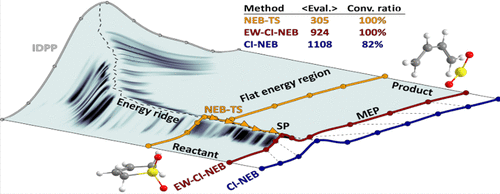当前位置:
X-MOL 学术
›
J. Chem. Theory Comput.
›
论文详情
Our official English website, www.x-mol.net, welcomes your
feedback! (Note: you will need to create a separate account there.)
Nudged Elastic Band Method for Molecular Reactions Using Energy-Weighted Springs Combined with Eigenvector Following
Journal of Chemical Theory and Computation ( IF 5.7 ) Pub Date : 2021-07-18 , DOI: 10.1021/acs.jctc.1c00462 Vilhjálmur Ásgeirsson 1 , Benedikt Orri Birgisson 1 , Ragnar Bjornsson 2 , Ute Becker 3 , Frank Neese 3 , Christoph Riplinger 4 , Hannes Jónsson 1
Journal of Chemical Theory and Computation ( IF 5.7 ) Pub Date : 2021-07-18 , DOI: 10.1021/acs.jctc.1c00462 Vilhjálmur Ásgeirsson 1 , Benedikt Orri Birgisson 1 , Ragnar Bjornsson 2 , Ute Becker 3 , Frank Neese 3 , Christoph Riplinger 4 , Hannes Jónsson 1
Affiliation

|
The climbing image nudged elastic band method (CI-NEB) is used to identify reaction coordinates and to find saddle points representing transition states of reactions. It can make efficient use of parallel computing as the calculations of the discretization points, the so-called images, can be carried out simultaneously. In typical implementations, the images are distributed evenly along the path by connecting adjacent images with equally stiff springs. However, for systems with a high degree of flexibility, this can lead to poor resolution near the saddle point. By making the spring constants increase with energy, the resolution near the saddle point is improved. To assess the performance of this energy-weighted CI-NEB method, calculations are carried out for a benchmark set of 121 molecular reactions. The performance of the method is analyzed with respect to the input parameters. Energy-weighted springs are found to greatly improve performance and result in successful location of the saddle points in less than a thousand energy and force evaluations on average (about a hundred per image) using the same set of parameter values for all of the reactions. Even better performance is obtained by stopping the calculation before full convergence and complete the saddle point search using an eigenvector following method starting from the location of the climbing image. This combination of methods, referred to as NEB-TS, turns out to be robust and highly efficient as it reduces the average number of energy and force evaluations down to a third, to 305. An efficient and flexible implementation of these methods has been made available in the ORCA software.
中文翻译:

使用能量加权弹簧结合特征向量跟随进行分子反应的轻推弹力带方法
攀爬图像轻推松紧带方法 (CI-NEB) 用于识别反应坐标并找到代表反应过渡状态的鞍点。它可以有效地利用并行计算,因为离散点(即所谓的图像)的计算可以同时进行。在典型的实现中,通过用同样刚度的弹簧连接相邻的图像,图像沿着路径均匀分布。但是,对于具有高度灵活性的系统,这会导致鞍点附近的分辨率较差。通过使弹簧常数随能量增加,鞍点附近的分辨率得到提高。为了评估这种能量加权 CI-NEB 方法的性能,对 121 个分子反应的基准集进行了计算。根据输入参数分析该方法的性能。发现能量加权弹簧大大提高了性能,并使用相同的一组参数值对所有反应进行了平均不到一千次能量和力评估(每个图像约一百次),从而成功定位鞍点。通过在完全收敛之前停止计算并使用特征向量跟随方法从攀爬图像的位置开始完成鞍点搜索,可以获得更好的性能。这种被称为 NEB-TS 的方法组合被证明是稳健且高效的,因为它将能量和力评估的平均数量减少到三分之一,即 305。这些方法的高效和灵活实施已经完成在 ORCA 软件中可用。
更新日期:2021-08-10
中文翻译:

使用能量加权弹簧结合特征向量跟随进行分子反应的轻推弹力带方法
攀爬图像轻推松紧带方法 (CI-NEB) 用于识别反应坐标并找到代表反应过渡状态的鞍点。它可以有效地利用并行计算,因为离散点(即所谓的图像)的计算可以同时进行。在典型的实现中,通过用同样刚度的弹簧连接相邻的图像,图像沿着路径均匀分布。但是,对于具有高度灵活性的系统,这会导致鞍点附近的分辨率较差。通过使弹簧常数随能量增加,鞍点附近的分辨率得到提高。为了评估这种能量加权 CI-NEB 方法的性能,对 121 个分子反应的基准集进行了计算。根据输入参数分析该方法的性能。发现能量加权弹簧大大提高了性能,并使用相同的一组参数值对所有反应进行了平均不到一千次能量和力评估(每个图像约一百次),从而成功定位鞍点。通过在完全收敛之前停止计算并使用特征向量跟随方法从攀爬图像的位置开始完成鞍点搜索,可以获得更好的性能。这种被称为 NEB-TS 的方法组合被证明是稳健且高效的,因为它将能量和力评估的平均数量减少到三分之一,即 305。这些方法的高效和灵活实施已经完成在 ORCA 软件中可用。





















































 京公网安备 11010802027423号
京公网安备 11010802027423号